Abstract
Inefficiency and poor quality are the main problems in polishing natural heterogeneous marbles using sol-gel (SG) diamond pads. A strategy was proposed to address these issues by establishing a natural heterogeneous marble polishing model based on the optimal polishing time. The surface evolution and optimal time for polishing natural heterogeneous marble were systematically investigated. Six different types of marbles were polished by the sol-gel diamond pads. The surface glossiness, roughness, peak–valley value, and surface morphology of the marbles were measured and analyzed after different polishing times. The optimal polishing time for each marble was revealed using sol-gel diamond pads. The experimental results show that the standard deviation of the hardness distribution of marble tile significantly affects the material removal inconsistency and evolution of the surface during polishing, resulting in different optimal polishing times for different kinds of marble. The larger the standard deviation of the hardness of the marble is, the more difficult it is to obtain better surface quality, and the orange peel effect is more likely to occur. Furthermore, the optimal polishing time has a good logarithmic relationship with the standard deviation of the hardness distribution. Finally, a curve model of the optimal polishing time for each marble was established. The determination of the optimal polishing time can effectively optimize the polishing process, simplify the processing flow, improve production efficiency, and reduce production costs. The proposed method and obtained results in this paper can provide a theoretical basis and reference for polishing other types of heterogeneous stone materials.
1. Introduction
Natural marble is one typical construction material with a long history. Due to its unique color, natural texture, sense of beauty, and grandeur effect, polished marble tile is widely used as decoration material in construction projects, such as floors, walls, columns, and stairs [1,2]. Natural marble tile is generally cut from marble blocks using diamond saw blades or row saws, then undergoes grinding and polishing processes in sequence. Polishing is the essential step to acquire a high-gloss surface during marble tile production [3,4,5,6,7]. Due to the complex physical composition and material properties of natural marble, the polishing process of natural marble tiles results in inefficiency, poor surface quality, and a cost accounting for more than 40% of the total product cost [8,9].
Numerous scholars have conducted extensive research on process parameters such as pressure, rotation speed, and the trajectory of abrasive grains during polishing, tailoring their approaches to the specific attributes of different marble types [3,8,9,10,11,12,13]. The findings have significantly contributed to the advancement of the marble polishing industry. However, most research focused on resin-bonded fixed-abrasive tools. These tools often encounter challenges in achieving uniform distribution of fine-grained or ultra-fine-grained abrasives, leading to a heightened issue of abrasive agglomeration. This agglomeration tends to generate deep scratches, which significantly impact the overall quality of the marble surface [14]. To mitigate the issues associated with traditional fixed abrasive tools, researchers have explored various approaches to develop innovative polishing tools [15,16,17,18]. The sol-gel (SG) polishing pad is a semi-consolidated flexible abrasive polishing pad that features efficiency and eco-friendliness, making it a trending polishing tool at present [19]. It surpasses traditional resin polishing tools in its ability to efficiently polish marbles, yielding a high-gloss finish while streamlining processes and reducing costs [14,18,20,21].
However, the heterogeneous nature of marble exhibits uneven hardness distribution on marble surfaces, which poses a challenge to achieving high-gloss marble surfaces during polishing. Using the SG polishing pad, the heterogeneous marbles undergo a trend where surface quality initially improves but then starts to deteriorate as polishing time progresses. This distinctive phenomenon is referred to as the orange peel effect, which distinguishes the marble polishing process from that of other single-crystal hard and brittle materials [5,9,22]. At present, the industrial production of marble mainly relies on experienced engineers to perform many tentative tests on a certain type of marble tile and then find a relatively good processing technology for actual production. This method can properly solve the problems encountered in industrial production, and the glossiness effect and economic value of polished marble are improved to a certain extent. However, this is only a qualitative method with strong subjectivity and randomness. When utilizing other types of marbles, it is necessary to repeat the tentative tests, which have low efficiency and high cost. Hence, it becomes imperative to investigate how the uneven hardness distribution of natural heterogeneous marbles affects the surface evolution mechanism during the polishing process and create a robust theoretical model to steer industrial production to enhance the surface quality of marble. Such endeavors not only improve production efficiency but also augment economic value while concurrently reducing production costs [23,24].
In this research, a variety of marbles were polished using the SG polishing pad. The marble surface hardness and its distribution characteristics for different types of marble were analyzed. The surface glossiness throughout the polishing process was monitored, and the formation mechanism of the orange peel effect on marble surfaces was revealed. Leveraging the surface evolution mechanism, the polishing process was optimized. A comprehensive theoretical model was developed by considering the relationship between the ideal polishing duration and the standard deviation of the distribution of marble hardness. The polishing model established can be used to guide the polishing of various types of natural marble and provide a theoretical basis for the polishing of other heterogeneous composite materials.
2. Experimental Details
2.1. Materials
In this study, six representative marbles in the market were purchased from a professional stone factory. The mechanical and physical properties of these marbles are shown in Table 1 (the testing method is consistent with the method described in reference [25]). These marbles included two categories: polished finished products (illustrated in Figure 1) and rough-ground semi-finished products, which were used for hardness measurement and polishing experiments, respectively.

Table 1.
Some physical and mechanical properties of the marble tiles investigated [25].
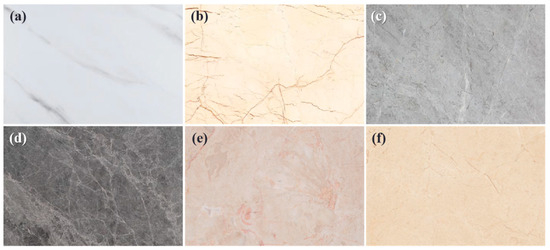
Figure 1.
Natural marble tiles used in this study: (a) Volakos (VO), (b) Sofitel King (SK), (c) Castle Gray (CG), (d) Yinding Gray (YG), (e) Focus Cream (FC), and (f) Crema Marfil (CM). The optical images were taken by a camera.
2.2. Fabrication of SG Polishing Pads
The SG polishing pads were fabricated using sodium alginate for polishing experiments. As shown in Figure 2, the manufacturing process of the SG polishing pad mainly includes four steps: 1. uniform dispersion of abrasive particles within the sodium alginate solution; 2. flattening the mixed solution on a flat plate to create a thin film; 3. immersion of the thin film and flat plate in a Ca2+ solution to facilitate gelation; and 4. drying the gel film. Figure 3a shows a typical SG polishing pad with a grain size of 20 μm. The microstructure of the SG polishing pad in Figure 3b indicated the diamond grains were evenly distributed on the pad. The average tensile strength and shore hardness of the formed SG polishing pad are 32.7 MPa and 63.4 HA, respectively [24].

Figure 2.
Schematic of the fabrication process of the SG polishing pads.
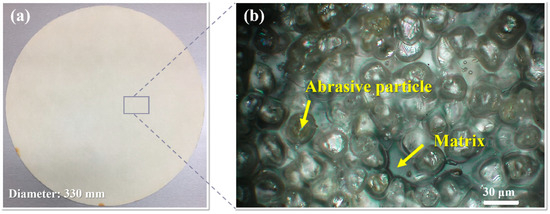
Figure 3.
(a) SG polishing pad with a grain size of 20 μm and (b) its microstructure. Images (a) and (b) were taken by a camera and a Hirox KH8700 3D digital microscope, respectively.
2.3. Hardness Measurement
The hardness of marble tile was measured using a micro Vickers hardness tester (HV-1000A, Huayin, China) loading a weight of 100 g for 10 s. To obtain the hardness distribution of each type of marble tile, 30 points were evenly tested on the surface.
2.4. Polishing Experiment
The semi-finished marbles were cut into dimensions of 60 mm × 60 mm × 20 mm. As shown in Figure 4a,b, before the polishing experiments, these semi-finished marble samples were pre-ground for 8 min using 34 μm and 7 μm traditional fixed abrasive grinding pads on a polishing machine, respectively. Then, the pre-ground marbles were polished with 20 μm SG polishing pads to investigate the optimal polishing time. The optimal surface glossiness sample from the previous process was used to investigate the optimal polishing time for 10 μm and 5 μm polishing pads, respectively, as shown in Figure 4c. The grinding or polishing pad and the marble rotated counterclockwise. According to the simulation results of the abrasive particle trajectory, the speed ratio of the pad and the marble tile was set to 2.16, and a constant pressure of 1.5 kg was maintained. In addition, pure water was used for cooling and lubrication during polishing.

Figure 4.
(a) Illustration of the marble tile polishing process, (b) pre-grinding with traditional grinding pad, and (c) polishing with SG polishing pad.
2.5. Polished Surface Evaluation
During the experiment, the glossiness of the marble surface was measured every minute using a digital glossiness meter (WG60G, Wave, Guangzhou, China) at a 60° angle. To comprehensively reflect the condition of the surface after polishing and reduce the error caused by manual measurement, 30 areas (each test area was 4 mm × 8 mm) were evenly tested on the surface every time. The surface roughness (Sa), peak–valley (Sz), and three-dimensional topography of the polished marble tile surface were measured by a laser confocal microscope (LM700, ZEISS, Oberkochen, Germany), and the area of each acquisition was 1210 μm × 1210 μm. Before each test, the marble tile surface was cleaned with pure water and blown dry with a blower.
3. Results and Discussion
3.1. Hardness of Marbles
The average hardness values are shown in Figure 5a. The orange error bar in each column represents the standard deviation of the distribution (SDD) of the hardness of all kinds of marbles. The detailed SDD value is given in Figure 5b. Although the average values of surface hardness between different marbles are relatively close, the SDD of the hardness of each marble is very different. The SDD of the hardness indirectly reflects the difference in the hardness of the composition of each kind of marble. The larger the SDD of the hardness, the greater the difference in the hardness of the composition and the worse the hardness consistency of the composition. Among these marbles, the SDD of the hardness of VO marble and CM marble tile is the largest and the smallest, respectively, which indicates that the hardness consistency of VO marble and CM marble are the worst and the best, respectively.
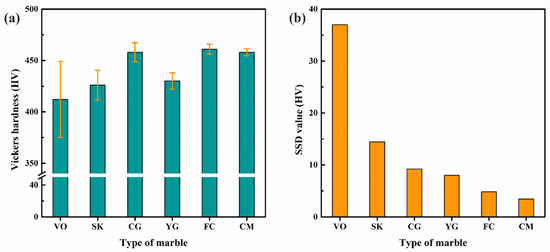
Figure 5.
(a) Vickers hardness and (b) SDD value of the hardness of the marble tiles.
3.2. Influence of Marble Hardness Distribution on Surface Glossiness
Figure 6a shows the average surface glossiness of marble tile after polishing by SG pad with a grain size of 20 μm. The entire polishing for each marble tile can be roughly divided into two stages: (1) the surface glossiness rise stage, during which the average surface glossiness of each marble tile increases with time, and the SDD of the surface glossiness decreases with time; (2) the surface glossiness decline stage, during which the average surface glossiness of each marble tile decreases with time, and the SDD of the surface glossiness increases with time. The moment when the inflection point of the surface glossiness appears is defined as the optimal polishing time. For each marble tile, the inflection point of the surface glossiness curve occurred at different times (as shown in Figure 6b), which indicated different optimal times of polishing for each marble tile by the SG pad.
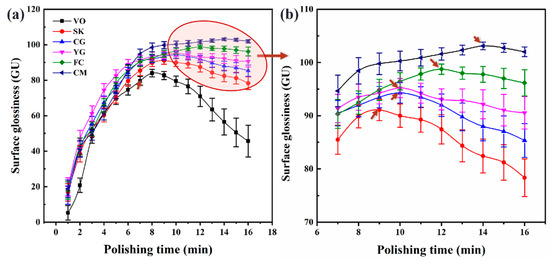
Figure 6.
(a) The surface glossiness–time curves of marble tiles during the polishing process using the SG pad with a grain size of 20 μm, (b) is the enlarged view of the red elliptical circle in (a).
Analyzing combined with the hardness of marble tile in Figure 5, as the hardness SDD of the marble decreases, both the maximum surface glossiness and the surface quality consistency and optimal polishing time rise. To be specific, VO marble tile has the worst consistency of hardness, and the best glossiness it can achieve is the lowest, taking the shortest time during the polishing process; CM marble tile has the best consistency of hardness, the best glossiness it can achieve is the highest, and its optimal polishing time is the longest. Furthermore, the poorer the hardness consistency of marble, the more likely the processing quality is to deteriorate after reaching the best surface glossiness, and the average and SSD of the surface glossiness are significantly reduced and increased, respectively.
The optimal polishing times for each marble tile using SG pads with grain sizes of 20 μm, 10 μm, and 5 μm were given in Table 2. In every process, the optimal polishing time increases as the SDD of the hardness of the marble tile decreases; furthermore, the optimal polishing time is shorter for the later process using a finer grain SG pad for the same marble tile. The rule above is consistent with the phenomenon presented in industrial production, and VO marble tile is defined as a difficult-to-polish marble by industry.

Table 2.
The optimal polishing times of different types of marbles polished by SG pads with different abrasive sizes.
3.3. Surface Evolution Mechanism during Polishing
The surface quality of VO marble tile was tracked at 4, 8, 12, and 16 min during the polishing. Figure 7 shows the surface roughness (Sa) and surface peak-to-valley value (Sz) of VO marble tile during the polishing process using an SG polishing pad with a grain size of 20 μm. Before polishing, both the surface Sa and Sz were very large, as shown in Figure 7, while the surface glossiness was very low, and it was almost matte. After being polished for 4 min, the Sa and Sz of VO marble tile decreased rapidly, and the surface glossiness increased rapidly, exceeding 60, while the SDD of the glossiness decreased.

Figure 7.
Surface roughness, surface glossiness, and surface peak–valley value of VO marble tile after polishing for different times with SG polishing pad with a grain size of 20 μm.
Although the surface scratches in Figure 8a were not completely removed after 4 min of polishing, the surface was free of deep scratches and relatively flat. Viewing from the line profile (corresponding to the red line in Figure 8a) shown in Figure 9a, the peak–valley (Rz) value is still greater than 9 μm, and the contour fluctuations are relatively uniform, indicating that the surface material is removed uniformly at this time. After 8 min of polishing, the surface quality of VO marble tile reached the best state, reaching a high-gloss surface with the glossiness exceeding 80, and the SDD of the glossiness was further reduced, indicating that the surface quality consistency was further improved, while the Sa and Sz also reached their minimum values.
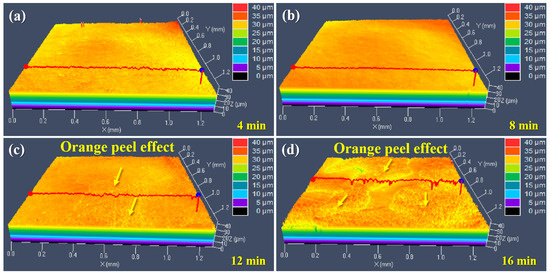
Figure 8.
Three-dimensional surface topography of the VO marble tile after polishing for different times with 20 μm diamond abrasive: (a) 4 min polishing, (b) 8 min polishing, (c) 12 min polishing, and (d) 16 min polishing.
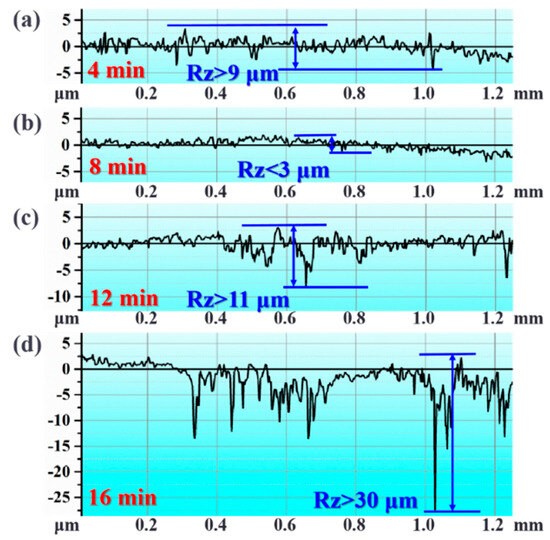
Figure 9.
Surface profile at different polishing times: (a) 4 min polishing, (b) 8 min polishing, (c) 12 min polishing, and (d) 16 min polishing.
As shown in Figure 8b, the surface of the VO marble tile is very flat and smooth, and the surface has almost no scratches. The surface material has a relatively complete ductile flow and spreads across the entire surface. The line profile (corresponding to the red line in Figure 8b) given in Figure 9b indicates that the surface contour fluctuates very little at this time; the Rz value is already less than 3 μm. After being polished for 8 min, the surface quality of the VO marble tile began to deteriorate: the Sa and Sz increased, and the glossiness decreased to approximately 70, while the glossiness SDD also increased, which indicated the consistency of the surface quality deteriorated.
As shown in Figure 8c, some areas on the surface of the VO marble tile became rough and had deep scratches due to inconsistent material removal. The Rz value of the line profile (corresponding to the red line in Figure 8c) shown in Figure 9c had exceeded 11 μm. As the polishing time further increased to 16 min, this phenomenon became more serious. The glossiness decreased rapidly, and its SDD value further increased.
As seen in Figure 8d, most of the material on the original smooth surface is unevenly removed, making the entire surface undulating. Scratches of varying depth appear on the surface, and the Rz value of the line profile (corresponding to the red line in Figure 8d) shown in Figure 9d even exceeds 30 μm.
The experimental results show that the surface quality and consistency of marbles did not continue to increase with increasing polishing time, which is very different from the case in the polishing of single-crystal hard-brittle materials. This is mainly because natural marble is composed of a variety of soft and hard materials, and the surface shows a characteristic of inconsistent hardness distribution, which causes great difficulties in polishing marble. To maximize the quality of the polished surface of marble, the optimal polishing time must be selected according to the hardness distribution characteristics of various types of marble. Otherwise, the inconsistent removal of different soft and hard materials on the marble during polishing would take place, and the material of the surface will have incomplete ductile flow, which will seriously affect the surface quality and quality consistency. This phenomenon of incomplete ductile flow caused by the uneven removal of materials is called the orange peel effect in industry and academia [5,26,27]. This orange peel effect was discovered very early, and some scholars have qualitatively analyzed the reasons for this phenomenon. However, thus far, there are few works to quantitatively analyze the mechanism for this phenomenon, and no corresponding theoretical model has been established to avoid this phenomenon.
To quantitatively reveal the cause of the orange peel effect during the polishing of marble tile, the hardnesses of the smooth and rough zones of the surface were measured with a microhardness tester, as shown in Figure 10. The average hardness value of the rough zone is HV = 373 ± 15, and the average hardness value of the smooth zone is HV = 406 ± 8. This shows that the zone where the surface remains smooth is harder, while the rough zone is relatively soft.
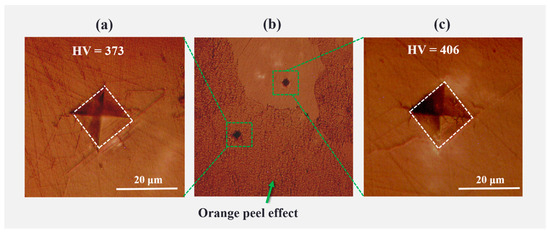
Figure 10.
Vickers hardnesses of different zones of the marble tile surface after the orange peel effect appeared during polishing: (a) Vickers hardness of the rough zone, (b) surface with the orange peel effect, and (c) Vickers hardness of the smooth zone. The green arrow pointed in (b) is the zone with orange peel effect, and the green rectangle represents the location where hardness was tested.
Figure 11 shows the surface evolution mechanism of marble tile during polishing. The exposure height of the abrasive particles on the SG pads is inconsistent during the polishing process because of the rough and uneven marble tile surface. Each abrasive grain appears to have a different degree of yield, which leads to different yield pressures for each abrasive grain [14,21], as shown by the blue arrow in Figure 11. This yield force directly affects the polishing pressure of abrasive grains on the surface of marble. At the beginning of the polishing stage, due to the rough and uneven marble tile surface, a lot of material must be removed. The material removal mainly occurs via brittle fracture. The contact area between the marble tile and the abrasive particles is relatively large, and the contact pressure is relatively small, as shown in Figure 11b. When polishing, to a certain extent, the rough and uneven stone surface is almost removed, and the surface tends to become smooth. The material removal occurs mainly by ductile flow, which spreads over the entire surface to obtain a smooth plane. At this time, the contact area between the marble tile surface and the abrasive particles decreases, resulting in increased contact pressure, as shown in Figure 11c. Since natural marble tile is composed of a variety of materials with uneven degrees of hardness and softness, there are hard zones and soft zones on the stone surface, as shown in Figure 11. As the polishing process continues, this phenomenon of inconsistent yield pressure leads to different degrees of material removal by abrasive particles on the marble tile surface with inconsistent hardness. Abrasive particles pass over the hard zones and cut into the soft zones to expose the rough surface, resulting in incomplete ductile flow, poor surface quality, and quality consistency, as shown in Figure 10 and Figure 11d. This material removal inconsistency directly leads to the orange peel effect on the marble tile surface, and this phenomenon becomes increasingly obvious with increasing polishing time. By analyzing Figure 10 and Figure 11, the results of measuring these zones with different polishing effects show that the hardness values vary greatly in different zones, which explains why the VO marble tile is most likely to show the orange peel effect during polishing.
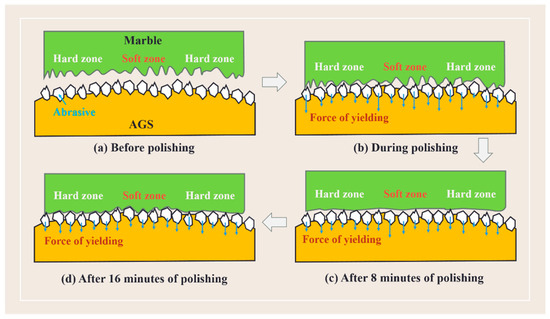
Figure 11.
Illustration of the deteriorating mechanism of the polishing surface of VO marble: (a) before polishing, (b) during polishing, (c) after 8 min of polishing, and (d) after 16 min of polishing.
3.4. Optimization of the Polishing Process Based on the Surface Evolution Mechanism
Natural marbles cannot avoid the uneven hardness of the composition. How to polish marble and obtain the best surface quality with existing technology has become a significant problem for industry and academia. This study takes VO marble tile as an example, which is defined as a type of marble that is difficult to polish by the industry, and it is also the type with the largest SDD in hardness among the six kinds of marble. According to the optimal polishing time of the SG polishing pad for each particle size of the abrasives in Table 2, the polishing times with the diamond abrasives of 20 μm, 10 μm, and 5 μm were selected to be 8 min, 7 min, and 5 min, respectively. The optimized polishing process is as follows: after polishing using the SG polishing pad for 8 min with the size of 20 μm abrasive particle, the size of 10 μm abrasive particle was used for continued polishing for 7 min, and, finally, polishing was continued by the size of 5 μm abrasive particle for 5 min.
Figure 12 shows the surface quality after polishing. As the abrasive particle size decreased, the surface quality of marble tile after polishing further improved, and the surface Sa and Sz continued to decline. After polishing with the 5 μm diamond particle, the glossiness of the surface of VO marble exceeded 100, reaching the ultra-glossiness level, and the SDD of glossiness was very small. This shows that the surface material ductile flows and spreads well, showing good quality consistency.
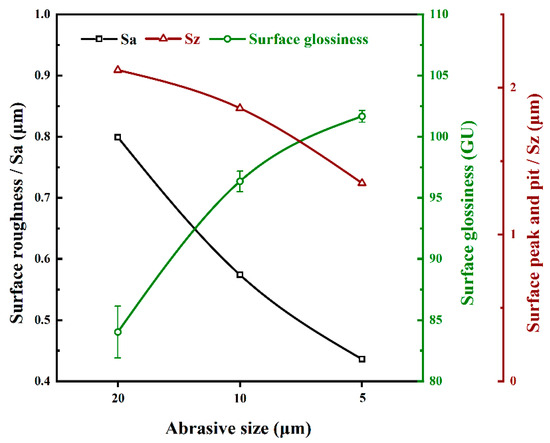
Figure 12.
Surface roughness, glossiness, and surface peak–valley of VO marble tile after polishing with different diamond abrasive sizes.
As shown in Figure 13, after polishing by three abrasives with different particle sizes, a smooth and scratch-free surface is obtained. The profile of the red line on the surface in Figure 13 is shown in Figure 14. The Rz of the red line position on the surface of the marble tile after polishing with 20 μm abrasives is less than 3 μm, and the Rz values of the red line position after further polishing with 10 μm and 5 μm abrasives are even smaller, less than 2 μm and 1.5 μm, respectively. The surface contour tends to be flat and smooth, and the inherent glossiness effect of VO marble tile is shown to the greatest extent. At the same time, the phenomenon that the surface quality and quality consistency are improved with decreasing abrasive particle size also explains the polishing process of the marbles well. Each type of abrasive particle has a corresponding removal ability. Each polishing process removes the scratches left by the previous process while creating new and finer scratches. It also verifies the ability of the SG tool to effectively uniformly disperse the fine abrasive and effectively solves the problem that the fine abrasive is prone to agglomeration in the traditional tool.
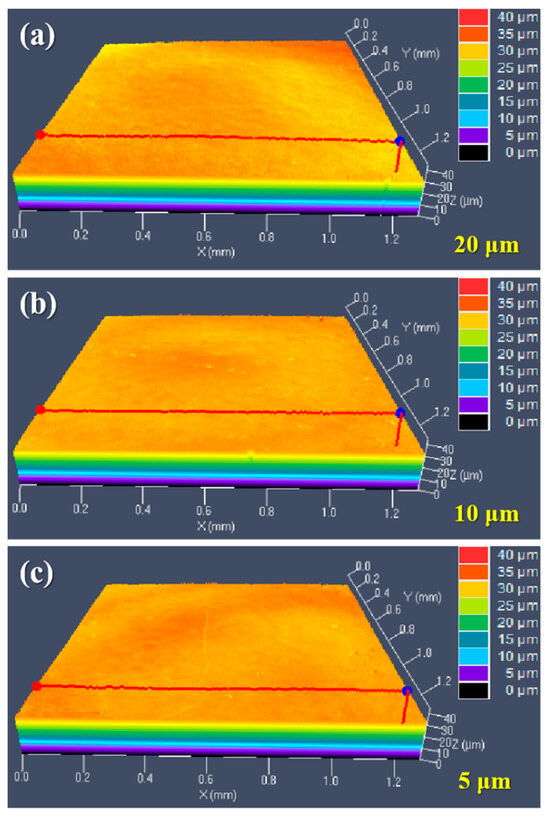
Figure 13.
Three-dimensional surface topography of the VO marble tile after polishing with an abrasive size of (a) 20 μm, (b) 10 μm, and (c) 5 μm.
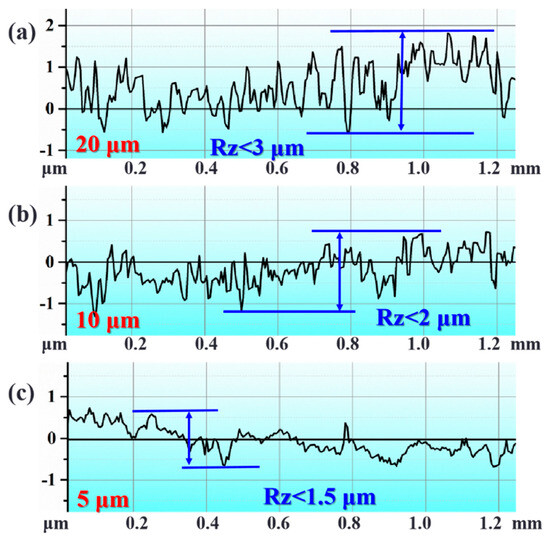
Figure 14.
Surface profile after polishing with different abrasive sizes: (a) 20 μm, (b) 10 μm, and (c) 5 μm.
Since the composition of natural marble tile has natural characteristics, different types of marble show different hardness distributions. From a microscopic point of view, the hardness of the material in any different position is different, showing the diversity and randomness of the hardness distribution; however, when viewed from a macro point of view, a certain kind of marble tile has the same mean hardness and SDD of the hardness. The optimal polishing times of the six kinds of marble polished by SG pads with different sizes of diamond abrasives are shown in Table 2 in Section 3.2. The relationship between the optimal polishing time and the SDD of the hardness of each kind of marble is shown in Figure 15. The fitting curve for the optimal polishing time and the SDD of the hardness of the different particle sizes is shown in Figure 15, where R2 is the degree of fit of the curve to the data points. It can be seen that, when different kinds of marble are polished by SG pads with different diamond abrasive sizes, the optimal polishing time has a good logarithmic relationship with the SDD of the hardness.
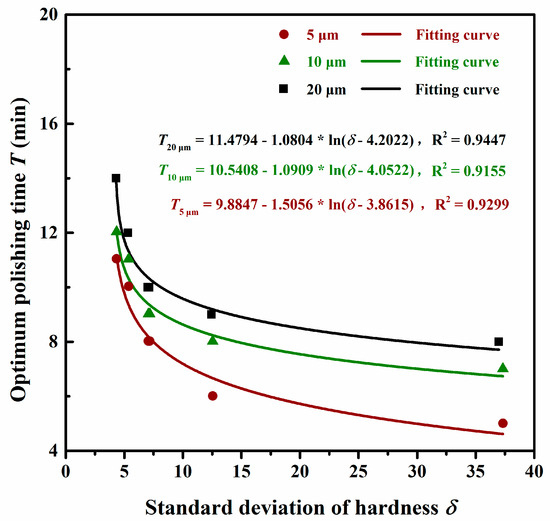
Figure 15.
The relationship between the optimal polishing time and the SDD of the hardness of different types of marble.
Figure 5, Figure 6 and Figure 15 show that the SDD of the hardness of all kinds of marble tile is an important factor affecting the optimal polishing time. The larger the SDD of the hardness, the shorter the optimal polishing time for each particle size abrasive. Conversely, the marble surface quality can be improved to a greater extent by appropriately increasing the polishing time. Therefore, when the processing equipment and conditions are determined, the actual industrial production of different kinds of marble can be guided by establishing a curve model as shown in Figure 15.
4. Conclusions
In this study, six different kinds of marble were polished by SG pads. The changes in surface glossiness, Sa, Sz, and surface morphology of the marble surface after different polishing times were analyzed. The polishing process of marble tile was optimized according to the surface evolution mechanism. The effect of the uneven hardness distribution of marble on the surface evolution mechanism during polishing was revealed. The conclusions based on the above results and discussion are as follows:
- (1)
- The ease of polishing order is VO > SK > CG > YG > FC > CM according to the curve of surface glossiness with time.
- (2)
- The key factor determining the difficulty of polishing is the hardness value deviation rather than the hardness value itself. The larger the SDD of the hardness of the marble, the more difficult it is to obtain a better surface quality.
- (3)
- The essence of the orange peel effect is caused by the inconsistent material removal rates of heterogeneous materials in local areas. The orange peel effect will become more apparent when the polishing is continued after the optimal polishing time.
- (4)
- The optimal polishing time has a good logarithmic relationship with the SDD of the hardness of different kinds of marbles. The established polishing model can be used for other heterogeneous natural marbles and provide theoretical basis guidance for other heterogeneous composite materials.
Author Contributions
Conceptualization, S.H. and J.L.; methodology, X.X.; software, S.H.; validation, S.H., J.L. and C.C.; formal analysis, X.X.; investigation, S.H.; re-sources, X.X.; data curation, S.H.; writing—original draft preparation, S.H.; writing—review and editing, S.H.; visu-alization, S.H.; supervision, S.H.; project administration, S.H.; funding acquisition, J.L. All authors have read and agreed to the published version of the manuscript.
Funding
This research was funded by [the National Natural Science Foundation of China] grant number [U1805251, 52405475], [Fujian Science and Technology Project] grant number [2022H0018] and Fujian New Century Outstanding Talent Support Program.
Institutional Review Board Statement
Not applicable.
Informed Consent Statement
Not applicable.
Data Availability Statement
Data is contained within the article.
Conflicts of Interest
The authors declare that they have no known competing financial interests or personal relationships.
References
- Mohammed, A.A.A.; Fener, M.; Comakli, R.; İnce, İ.; Balci, M.C.; Kayabalı, K. Investigation of the relationships between basic physical and mechanical properties and abrasion wear resistance of several natural building stones used in Turkey. J. Build. Eng. 2021, 42, 103084. [Google Scholar] [CrossRef]
- Martínez-Martínez, J.; Benavente, D.; Pérez-Huerta, A.; Cueto, N.; García-del-Cura, M.A. Changes on the Surface Properties of Foliated Marbles at Different Cutting Orientations. Constr. Build. Mater. 2019, 222, 493–499. [Google Scholar] [CrossRef]
- Kouam, J.; Songmene, V.; Bahloul, A.; Samuel, A.M. Characterization of Si and SiO2 in Dust Emitted during Granite Polishing as a Function of Cutting Conditions. Materials 2022, 15, 3965. [Google Scholar] [CrossRef] [PubMed]
- Bahri, H.; Songmene, V.; Kouam, J.; Samuel, A.M.; Samuel, F.H. CNC Edge Finishing of Granite: Effect of Machining Conditions on Part Quality, Cutting Forces, and Particle Emissions. Materials 2021, 14, 6496. [Google Scholar] [CrossRef] [PubMed]
- Görgülü, K.; Ceylanoǧlu, A. Evaluation of Continuous Grinding Tests on Some Marble and Limestone Units with Silicon Carbide and Diamond Type Abrasives. J. Mater. Process. Technol. 2008, 204, 264–268. [Google Scholar] [CrossRef]
- Cserta, E.; Gyurika, I.G. Effects of the granite-forming minerals on the surface roughness in the milling processes. Int. J. Adv. Manuf. Technol. 2021, 112, 3041–3052. [Google Scholar] [CrossRef]
- Karaca, Z. Relationship between the Mechanical Properties and the Surface Roughness of Marble. Int. J. Mater. Res. 2012, 103, 633–637. [Google Scholar] [CrossRef]
- Cevheroǧlu Çira, S.; Daǧ, A.; Karakuş, A. Application of Response Surface Methodology and Central Composite Inscribed Design for Modeling and Optimization of Marble Surface Quality. Adv. Mater. Sci. Eng. 2016, 2016, 2349476. [Google Scholar] [CrossRef]
- Farhadian, A.; Ghasemi, E.; Hoseinie, S.H.; Bagherpour, R. Development of a new test method for evaluating the abrasivity of granite building stones during polishing process based on weight loss of abrasive tool. Constr. Build. Mater. 2021, 303, 124497. [Google Scholar] [CrossRef]
- Cevheroǧlu Çira, S.; Daǧ, A.; Karakuş, A. Investigation of the Effects of Marble Material Properties on the Surface Quality. Adv. Mater. Sci. Eng. 2018, 2018, 6514785. [Google Scholar] [CrossRef]
- Ribeiro, R.P.; Paraguassú, A.B.; Moreiras, S.T.F. Factors Affecting Slab Surface Roughness of Siliceous Dimension Stones. Bull. Eng. Geol. Environ. 2011, 70, 625–631. [Google Scholar] [CrossRef]
- Sousa, F.J.; Alarcon, O.E.; Weingärtner, W.L.; Fredel, M.C.; Vázquez, M.F.; Vilches, E.S. Evaluation of texture distribution during the industrial polishing process of porcelain stoneware tiles. J. Eur. Ceram. Soc. 2013, 33, 3369–3378. [Google Scholar] [CrossRef]
- Coelho, A.; Pereira, J.C.G.; Amaral, P.M.; Rosa, L.G. Gloss and Modelling Studies of Stone Polishing Using Linear Polishing Machines with Rotating Heads. Appl. Sci. 2022, 12, 7521. [Google Scholar] [CrossRef]
- Huang, S.; Lu, J.; Chen, S.; Huang, H.; Xu, X.; Cui, C. Study on the Surface Quality of Marble Tiles Polished with Sol-Gel Derived Pads. J. Sol-Gel Sci. Technol. 2019, 91, 485–495. [Google Scholar] [CrossRef]
- Luo, Q.; Lu, J.; Xu, X. Study on the processing characteristics of SiC and sapphire substrates polished by semi-fixed and fixed abrasive tools. Tribol. Int. 2016, 104, 191–203. [Google Scholar] [CrossRef]
- Lei, Y.; Feng, M.; Wu, K.; Chen, J.; Ji, J.; Yuan, J. Investigation on the Basic Characteristics of Semi-Fixed Abrasive Grains Polishing Technique for Polishing Sapphire (α-Al2O3). Materials 2022, 15, 3995. [Google Scholar] [CrossRef]
- Lu, J.; Deng, A.; Xiao, P. Preparation and Application of Sol-Gel Polishing Pad for Polishing CVD Single Crystal Diamond at High Speed. IEEE Trans. Semicond. Manuf. 2022, 35, 318–323. [Google Scholar] [CrossRef]
- Wang, W.; Yu, Y.; Hu, Z.; Fang, C.; Lu, J.; Xu, X. Removal Characteristics of Sapphire Lapping using Composite Plates with Consciously Patterned Resinoid-Bonded Semifixed Diamond Grits. Crystals 2020, 10, 293. [Google Scholar] [CrossRef]
- Luo, Q.; Lu, J.; Li, Z.; Wang, J. Fabrication of a sol–gel polishing tool for green manufacturing of the seal stone. J. Sol-Gel Sci. Technol. 2020, 96, 576–588. [Google Scholar] [CrossRef]
- Lin, Y.; Lu, J.; Tong, R.; Luo, Q.; Xu, X. Surface Damage of Single-Crystal Diamond (100) Processed Based on a Sol-Gel Polishing Tool. Diam. Relat. Mater. 2018, 83, 46–53. [Google Scholar] [CrossRef]
- Lu, J.; Xu, Y.; Zhang, Y.; Xu, X. The Effects of SiO2 Coating on Diamond Abrasives in Sol-Gel Tool for SiC Substrate Polishing. Diam. Relat. Mater. 2017, 76, 123–131. [Google Scholar] [CrossRef]
- Xu, Y.; Lu, J.; Xu, X.; Chen, C.C.A.; Lin, Y. Study on High Efficient Sapphire Wafer Processing by Coupling SG-Mechanical Polishing and GLA-CMP. Int. J. Mach. Tools. Manuf. 2018, 130–131, 12–19. [Google Scholar] [CrossRef]
- Amiril, S.A.S.; Sousa, F. The effect of pressure gradient and abrasive tool wear when polishing ceramic tiles. Mater. Today Proc. 2020, 46, 1770–1777. [Google Scholar] [CrossRef]
- Jin, M.; Wang, L.; Ye, S.; Qi, H.; Kang, J.; Hong, T.; Fang, Z.; Dong, X. A Novel Functionally Graded Lapping and Polishing Method for the Improvement of Material Removal Uniformity. J. Manuf. Process. 2020, 50, 102–110. [Google Scholar] [CrossRef]
- Ulusay, R. The ISRM Suggested Methods for Rock Characterization. In Testing and Monitoring, 2007–2014; Springer International Publishing: Cham, Switzerland, 2015. [Google Scholar]
- Pan, G.; Gong, H.; Gu, Z.; Zou, C.; Chen, G. Investigation on defect control for final chemical mechanical polishing of aluminum alloy. Proc. Inst. Mech. Eng. Part J-J. Eng. Tribol. 2014, 228, 1151–1158. [Google Scholar] [CrossRef]
- Trum, C.J.; Sitzberger, S.; Rascher, R. Improved performance of chemo-mechanical polishing CMP processes through targeted adjustment of polishing slurry and polishing pad. In Proceedings of the Optical Manufacturing and Testing XII, San Diego, CA, USA, 19–23 August 2018; p. 107420. [Google Scholar] [CrossRef]
Disclaimer/Publisher’s Note: The statements, opinions and data contained in all publications are solely those of the individual author(s) and contributor(s) and not of MDPI and/or the editor(s). MDPI and/or the editor(s) disclaim responsibility for any injury to people or property resulting from any ideas, methods, instructions or products referred to in the content. |
© 2024 by the authors. Licensee MDPI, Basel, Switzerland. This article is an open access article distributed under the terms and conditions of the Creative Commons Attribution (CC BY) license (https://creativecommons.org/licenses/by/4.0/).